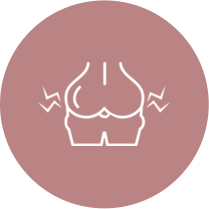From the moment we first meet with patients,
we will take care of them like a family with faith, hope, and love.
Wellness Hospital treats even the hearts of customers through experts treatment and specialized medical services.
Anal fissure refers to a condition in which the anal epithelium (the mucous membrane that is located up to 2cm deep from the anus) is torn or sore in a straight line during defecation.
2
What Causes Anal Fissure?
-
1
Anal fissures often develop after hard stools pass through the anal canal, which causes the skin of the anus to be stretched and torn.
-
2
Sometimes they can occur even after severe diarrhea. Some patients may start experiencing the symptoms when they start to have hard stools after recovering from diarrhea.
-
3
People who fail to relax their anus during their bowel movements can increase tension in their anal canals, making them more susceptibe to tearing.
-
4
Such a case is called defecation tension. In addition, about 10% of female patients may develop anal fissures after childbirth.
Why Do Anal Fissures Mainly Occur Behind (90%) and Anterior (10%) Part of the Anus?
Anal fissures usually occur at the anterior part of the anus, while female patients usually experience anal fissure in the center of the front area. About 10~20% of female patients and about 1~10% of male patients experience frontal anal fissure.
About 2.6% of anal fissures occur at the lateral areas of the anus. In these cases, Crohn’s disease, ulcerative colitis, syphilis, tuberculosis, leukemia, anal cancer, AIDS, etc can be background reasons for the fissure, so you should take tests for these diseases.
01
The anterior and posterior areas where the external anal sphincters cross are weaker than the left and right sides and thus more vulnerable to injuries.
02
The anal canal partially slides down from the anus during the discharge of feces from the rectum. However, the skin of the front and back of the anus is tightly anchored to the sphincters and cannot come out with the anal canal. Therefore, when the sliding happens, this area gets subjected to more tension and resistance, and thus becomes more susceptible to injury.
03
The contraction of the internal anal sphincters increases due to anal fissure, and thus the internal pressure of the anal canal increases. As the pressure increases, the capillaries get compressed, and blood circulation deteriorates.
3
Treatments of Anal Fissure?
Usually medical treatments like laxatives, dilatative laxatives, topical anesthetics, and corticosteroids are effective to anal fissures. Early symptoms of anal fissure can be improved by consuming raw bran twice a day for about a year.
Other corticosteroids and local anesthetics may also be used.
In general, in treating patients with chronic anal fissures, anal ulcers, or sometimes acute anal fissures involves serious pain who do not want conservative drug treatments, surgeries are required.
Surgical methods include anal dilatation (stretching sphincters) and sphincterotomy.
-
· The anal dilatation method:
It is the method of dilating anus and stretching anal sphincters by inserting four fingers into the anal canal, but there is a possibility of gas incontinence after the procedure.
-
· Lateral internal sphincterotomy
01 The open type
The open type involves an incision in the skin between the lateral sphincters of the anus (a). Then, the thickened internal sphincter is pulled out and cut.
02 The closed type
In the closed type, some fibers of the internal sphincter are cut with constant pressure by inserting a scalpel between the internal and external sphincters through the skin at the center of the left or right chamber of the anus. The lateral internal partial sphincterotomy takes about 5 minutes, and patients are usually discharged on the same day of the surgery. We also prefer and implement the surgical strategy most frequently, and have seen many positive results from the patients.













